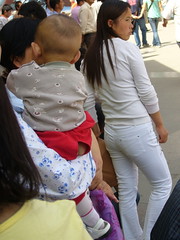My mother-in-law told me this past
weekend that all three of her kids shared one cloth diaper and that’s the
only diaper she ever needed. She went on to tell me that she started
potty training all of her kids on day three. Meaning that when they were
three days old she started potty training them!
At first I was shocked. Sounds
impossible. But, then I started asking questions and talking to Lawrance
more about it. Then of course I had to google it.
Throughout much of the non-Western world, infant toilet training is the norm. In India, China, Southeast Asia, Eastern Europe, the arctic, and parts of Africa and Latin America, parents leave baby bottoms uncovered (Boucke 2003; Sonna 2006; deVries and deVries 1977).
Diapers are considered unnecessary-—even disgusting. When babies have to pee or poop, parents hold them over a preferred target (e.g., a toilet, an outdoor latrine, or simply open ground) until business is done.
How do parents know when their babies need to go? By paying close attention. In these “bare-bottom” cultures, babies spend much of their days being carried around. Mom learns to read her baby’s cues. And-—eventually—-baby learns to hesitate until Mom gives her the “okay”-—usually signaled by a special vocalization, like “sheee-sheee” or “shuuuus” (Boucke 2003; deVries and deVries 1977).
 Sometimes called “elimination
communication,” this method is now being adopted by some parents in the United
States and other Western countries.
Sometimes called “elimination
communication,” this method is now being adopted by some parents in the United
States and other Western countries.
There is also a pdf that talks more about “Potty
Training” in China, where she gives the four basic steps to get started with
training an infant to go where you want them to go.
The authors also state that parents in
China can potty train their child so young because “there is an elimination
awareness ’window of learning’ open from birth to about 6 months of age.
If parents tap into this sensitive period, they generally have good
results with toilet training.”
So, perhaps it’s not as shocking as I
thought it was. But one thing for sure is that it takes LOTS of time on
the part of the caregiver (ie. mommy or, in many cases in Taiwan, grandma).
It depends on the caregiver always being near the child and being very
vigilant about “reading” and “learning” the child’s signals.
And, it might be labor intensive, time
consuming, and at times messy for mom, but it sure has other benefits too.
Just to start, think of all the money saved on diapers!
There is also a special way to hold a
baby or young one over a toilet–made easier if you are using a squatty
potty. Many in Taiwan also let their children go outside over a drain.
And, in case your wondering, the
vocalizations used here in Taiwan for “elimination communication” are a gentle,
breathy whistle or a “shuuu, shuuu” sound for peeing and grunting sounds like
“unh, unh” for pooing.
Here’s a CNN video of American parents
using this concept:
I give props to my mother-in-law for
her labor-intensive, money-saving way to raise my husband. I’m impressed!
It becomes even more impressive when I realized she had three under three
and used this method with all three of them! She’s amazing!
No comments:
Post a Comment